Famous Salvador Dali paintings with descriptions
If you want to know the essence of Surrealism, then get to know a bright representative of this direction in the painting of the 20th century. It's Salvador Dali. The Spanish artist's creations represent the philosophy and spirit of Surrealism, extravagance, and hyper-emotion. Learn some interesting facts about Salvador Dali paintings.
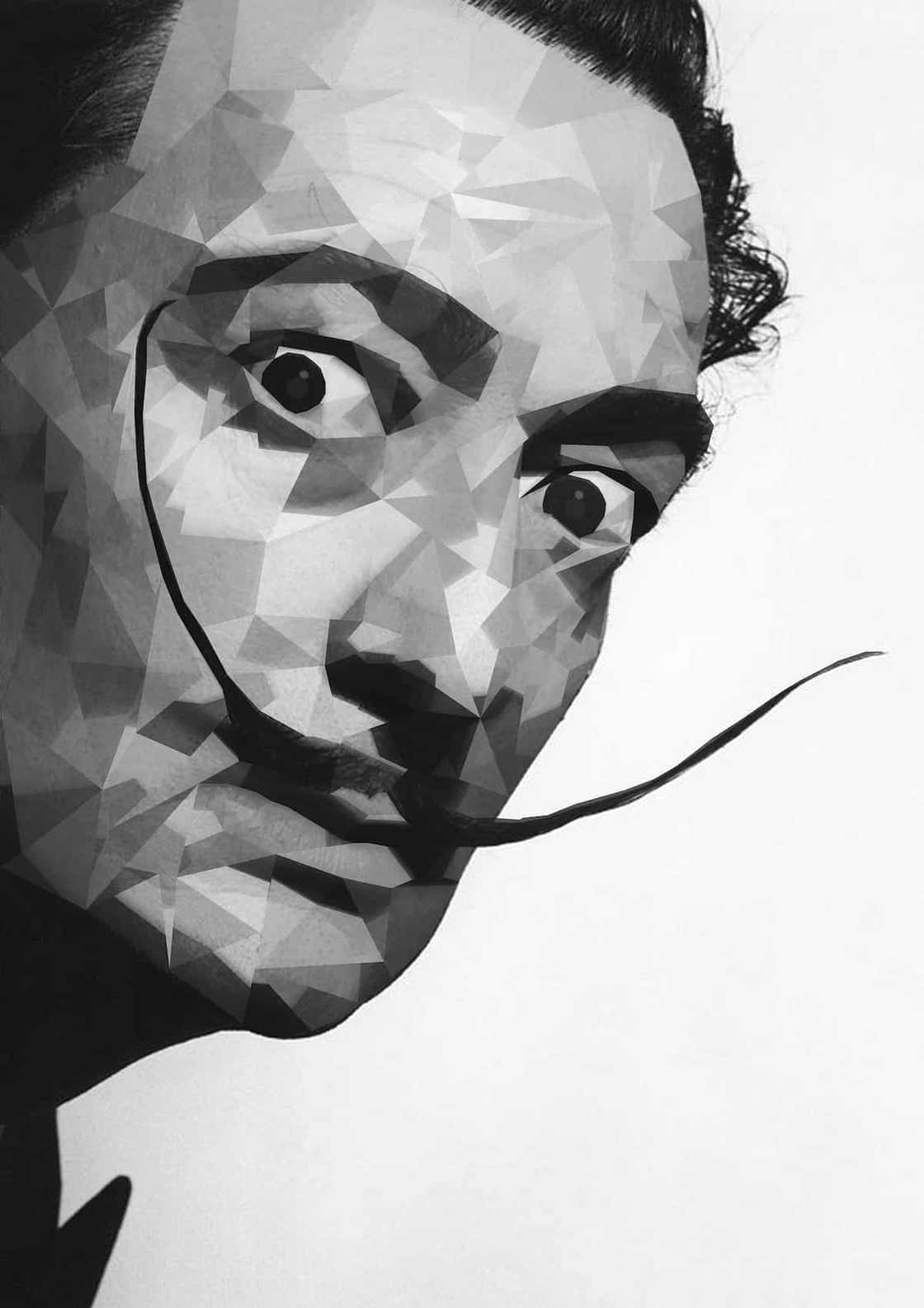
Source: UGC
Salvador Dali is identified with surrealism. Everything about the artist was consistent with this aesthetic concept: his thinking, manner of behavior, madness, freedom from moral prescriptions and stereotypical behavior, emotionality, and openness.
Dali is a maverick in art and life. He always did what he wanted, and wrote what he thought was appropriate. So it is no surprise that in the 1930s and 1950s, the public was shocked by his artistic experiments. The painter, who mastered the classical technique of drawing, was obsessed with Impressionism and Cubism, and eventually came to Surrealism.
This direction in art enabled the artist to speak frankly about the innermost things: to touch upon sex and eroticism, sexual perversions and repressed sexual desires, the destruction and self-destruction of the human being. But the main theme of his paintings is the illusions in which one finds a human being.
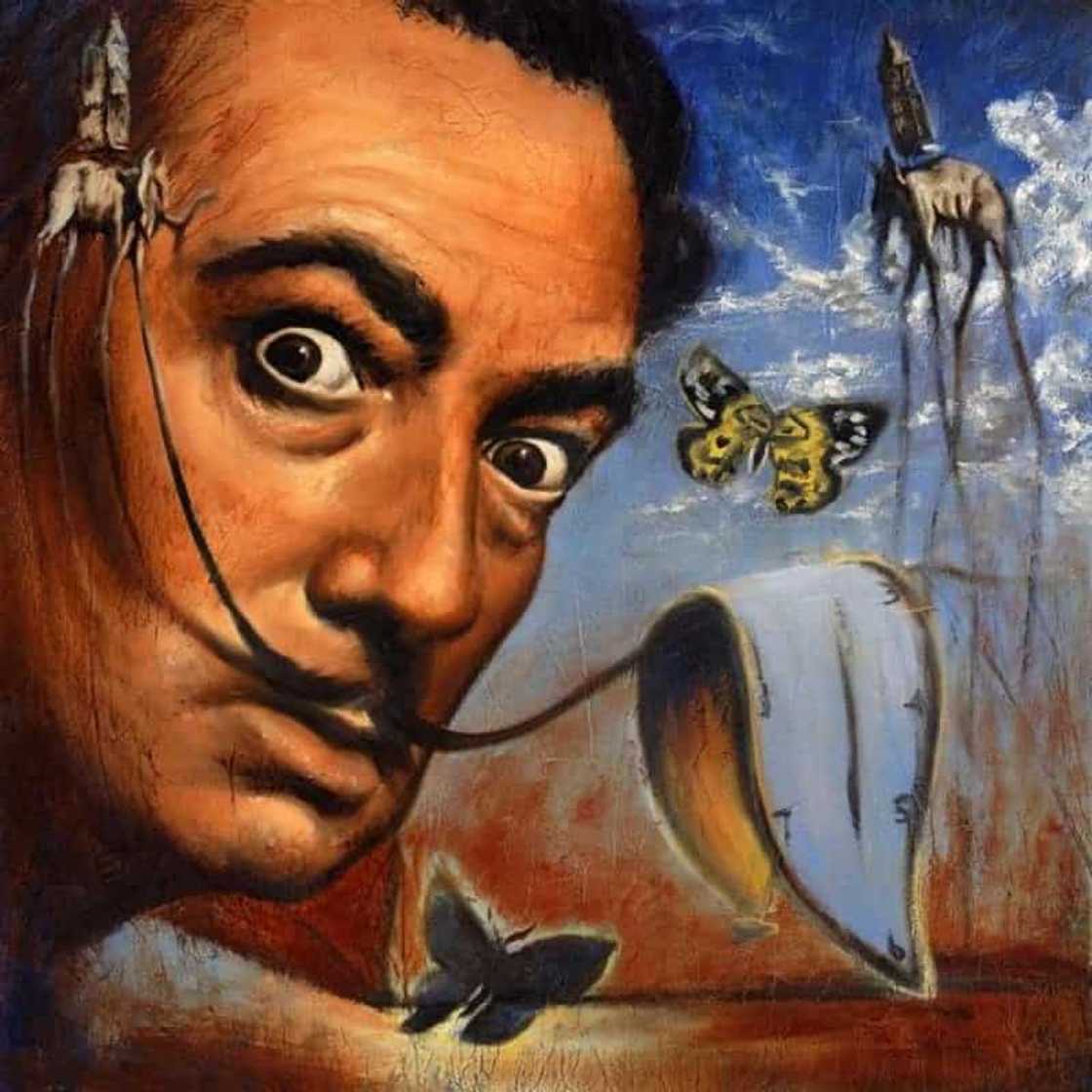
Source: UGC
Salvador Dali's paintings are difficult to interpret, to give logical explanations to particular images or details, to read their meaning. This is because they are composed of visual pun, schizoid images, allusions, and are built on the game of meanings and plots.
Here, we present the most famous Dali paintings with a brief description. Try to compare the meanings that art historians discover with the own impressions and emotions of these surreal canvases:
"Persistence of Memory" (1931)
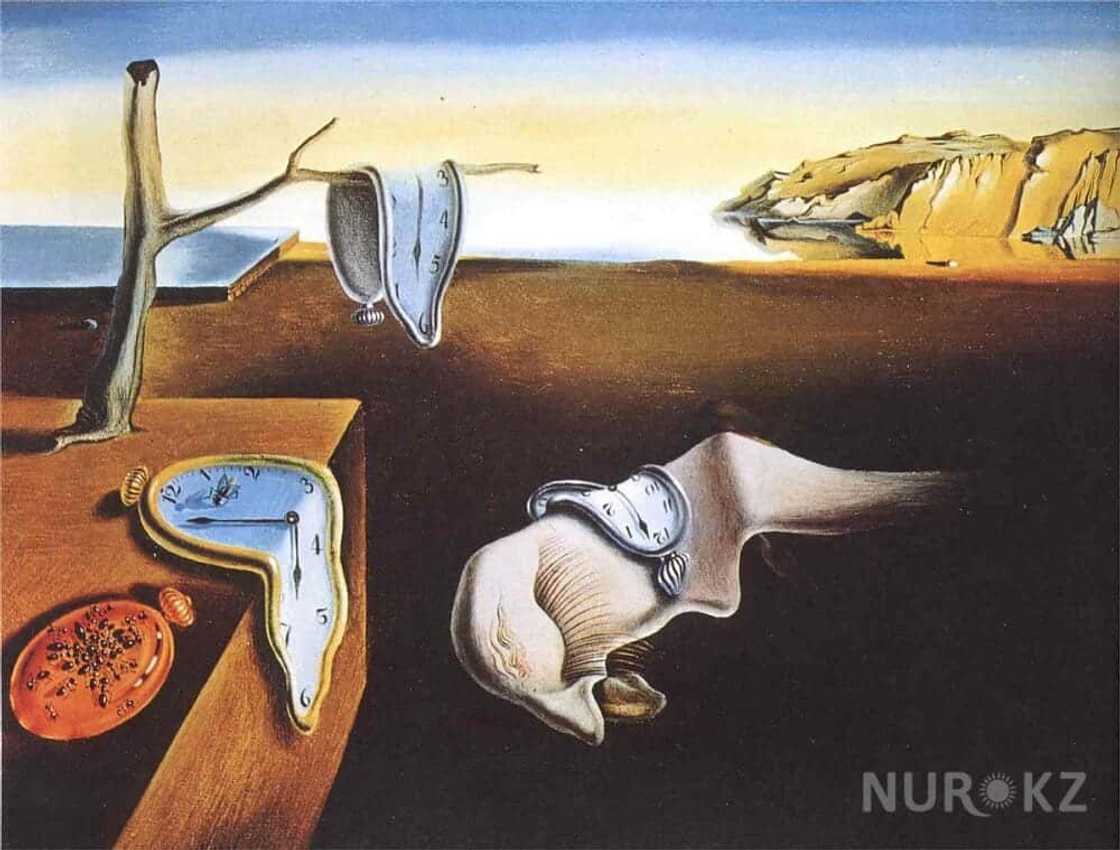
Source: Original
The painting has several titles: "Soft (fluid) clocks," "The flow of time," " Persistence of Memory". The great Dali hoaxer has repeatedly clarified the symbols on the canvas, but this further confounded art experts.
"Persistence of Memory" destroys the stereotype of human perceptions of time. The author emphasizes that it is far from the linearity with which passing time is often associated.
The idea for the painting came to Dali during breakfast when Gala put soft cheese on toast. The painter painted a picture overcoming migraines. Hence the frown of the tones, the prevalence of browns and greys.
The central image, the head on earth, in which Dali himself is recognized, is an embodied wish for peace and relaxation from pain. Other images (often found on his paintings) represent the idea of smoldering existence: ants and flies devour time, just as aging devours the body. The rocky coast and sea are symbols of immortality which is timeless, eternal, and therefore in the background. The dried olive tree, dried life. The whole picture expresses melancholy and fading.
Now this small painting (24x33 cm) is on display in the New York Museum of Modern Art.
Soft Construction with Boiled Beans (1936)
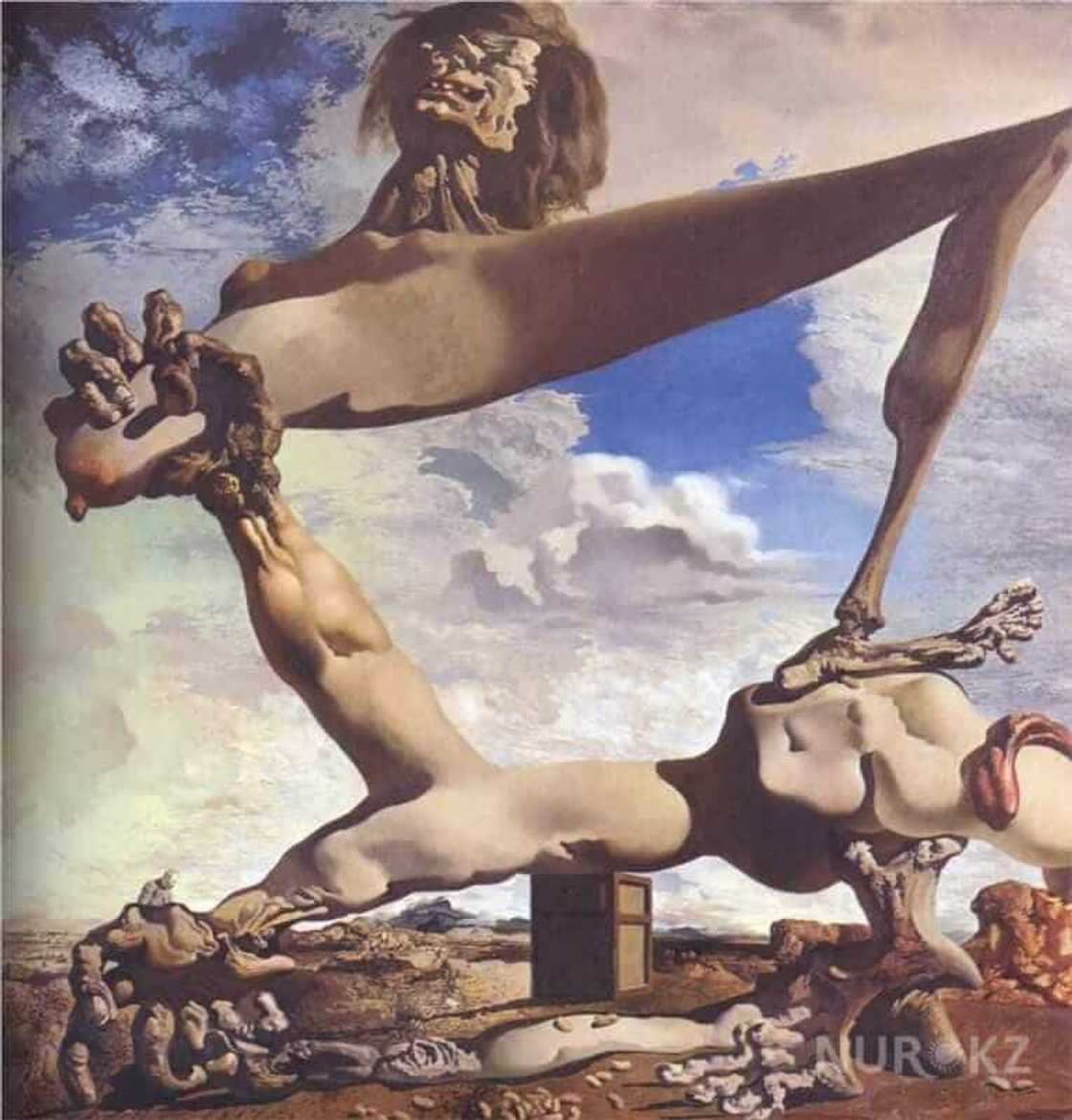
Source: Original
This painting represents Salvador Dali's reaction to the domestic political processes that penetrated in Spain in the late 1930s. It's Franco's time in power and the Republicans "struggle with nationalists. The country is on the verge of civil war.
Although Dali was a Franco supporter, the picture, which was supposed to depict positive changes in society, is striking phantasmagoric and eerie.
The political confrontation described above in Spain in 1936 is presented by the author in the image of two human bodies that have merged with different body parts and suffer from this. They seem to be fighting, seeking to secede, and cannot exist without each other, because that would be the way they lose their footing. A handful of boiled beans scattered around the craggy hand of one of the Atlantans is a symbol of the poverty that has gripped Spanish society.

Read also
Solenn Heussaff claps back at netizens who accused her of being "insensitive" in latest urban poor post
The painting is now being kept in Philadelphia, at the Museum of Art.
The Burning Giraffe (1936-1937)
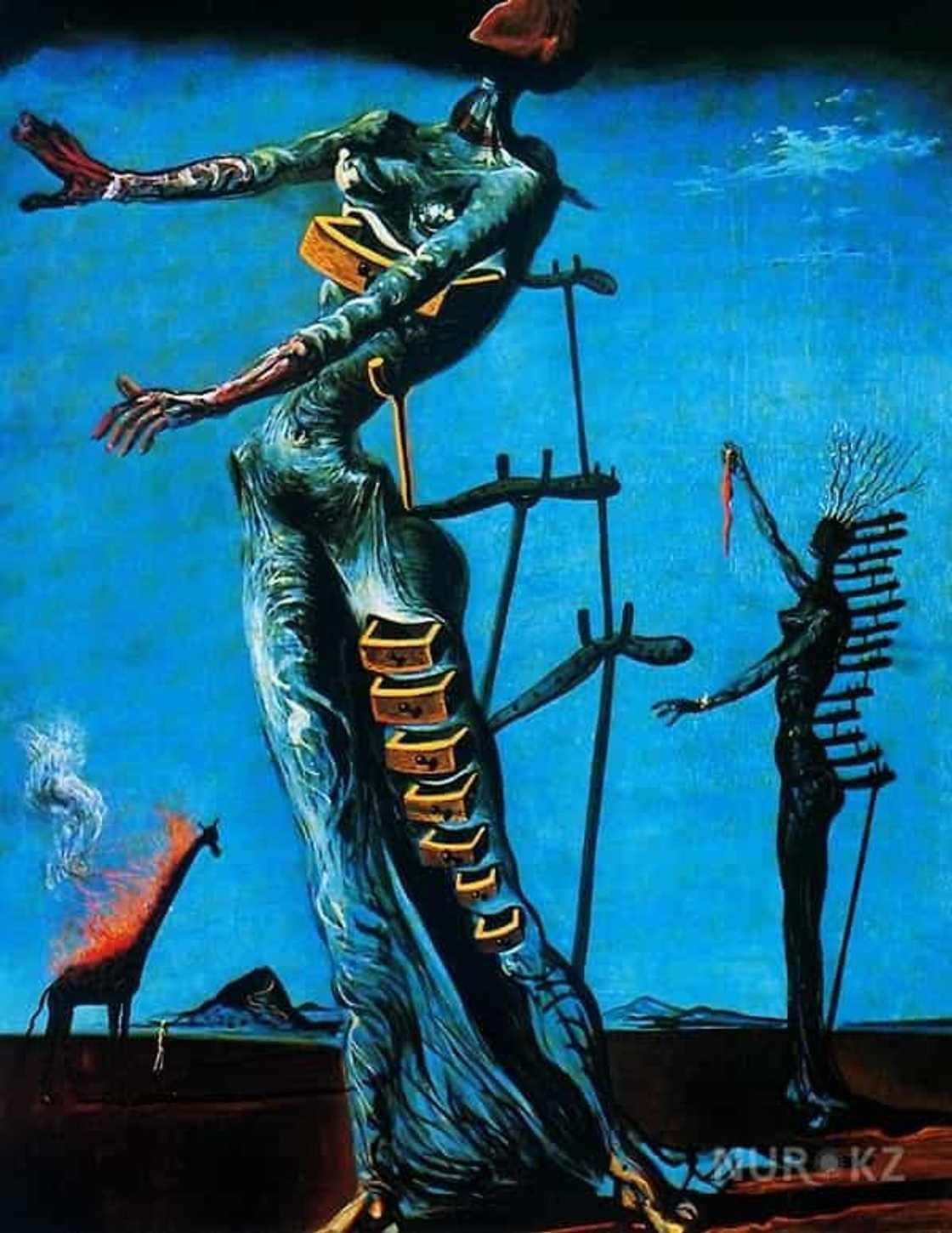
Source: Original
Another painting from a series of canvases, in which Dali conveyed his own experience and sense of war. The painting, like all his other creations, contains mystical-fantastic images that strike the imagination with their absurdity. But if you turn off rational thinking and rely solely on emotional perception, then all meanings become clear.
Two female figures (Dali's favorite image) are the embodiment of human consciousness. It is not resilient and reeling, it constantly needs support and support. Folding drawers are memories and thoughts that people tend to hide but at some point open to the public. This leads to tragedy (the bloody hands of heroines).
The giraffe, engulfed in flames, is placed on the background by the author. It symbolizes a male apocalyptic beginning. The overall picture is one of a sense of the war in Spain. The painting is now in the custody of the Basel Museum of Art.
Read also: Charyn Canyon: national park's history, photos, how to visit
The Swans reflecting Elephants (1937)
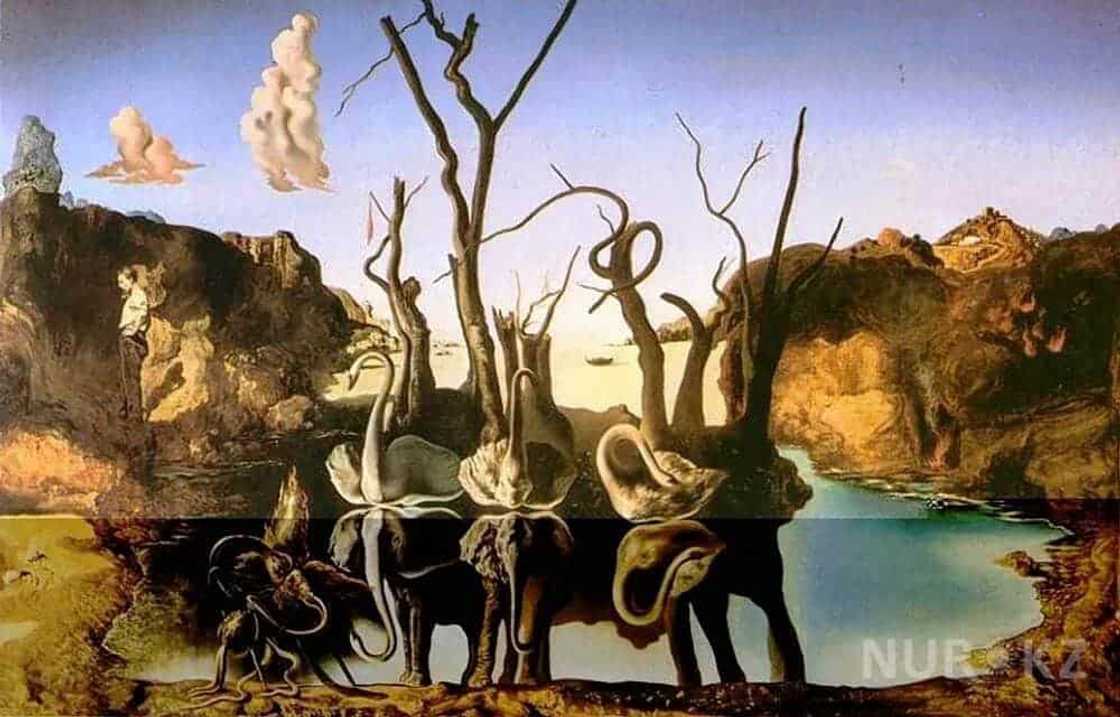
Source: Original
The theme of the illusion of all existence (the artist's favorite theme) is reflected in this creation. Here is a peculiar paranoid-critical method of the artist.
The canvas depicts his childhood trauma, cornered deep in the subconscious, and reminded of itself by animal-symbol images. The composition is designed to reveal the essence of the illusion in which man lives and which oppresses him.
Salvador Dali famously had an uneasy relationship with his parents. They were very sad about the first child they lost in infancy. So the second son was named as well as the first-born, Salvador. The future artist faced the illusion of reality at a young age: surrounded by his brother's children's clothes and toys, he could not know whether he was alive or dead, whether it was him or his brother.
The surrealist genius expressed these feelings and resentments in his painting "The Swans reflecting Elephants." Swans are the illusion of a decent and loving family, and elephants are the embodiment of true parental love.
Dali praised elephants for their selfless care for their offspring. Beyond this, elephants represent dominance and power, which little El Salvador clearly lacked to feel protected.
The mourner, pictured on the left against a backdrop of rocks, is the author himself, not ready to part with the hurt, not ready to face it.
The painting is now the property of a private collector.
The Enchanted Shore with Three Liquid Graces (1938)
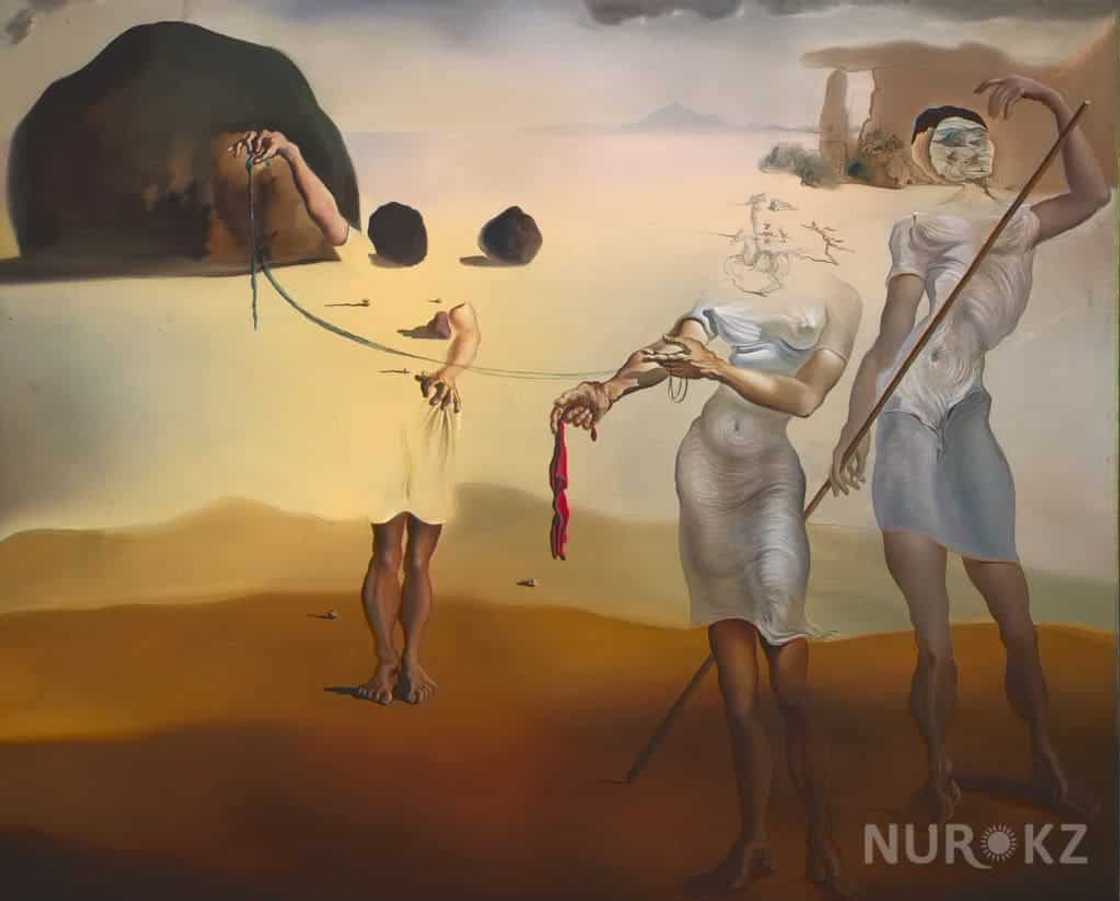
Source: Original
Many are familiar with the images of the Three Haritas, or Grace, from Greek mythology. They represent fun, grace, and inspiration. This is not surprising, because they serve the goddess of love Aphrodite. But there are also three other goddesses in Greek mythology, on which human destiny and longevity depend. It's Moira.
Salvador Dali decided to combine the two images by creating a way of life for the human soul. The first heroine with a long rope in her hands begins to weave the lace of fate. The second is a symbol of the maturity of the human soul when self-awareness comes. So only she has a clear identity.
By the way, if you look carefully at the features, you will see the rider racing and the person running after him. Those outlines symbolize a human desire to live faster, an eternal pursuit of dreams.
The third is the epitome of dying, so her face is stone. This is how the soul freezes after death. So the figure of the third Grazia Moira almost blends into the landscape, while the other two have distinct female forms.
The backdrop on which they are depicted is also symbolic: the sandy shore is a fleeting human life, and the sea is eternal.
It is stored in Figueres, in the museum-theater created by the author.
Dream Caused by the Flight of a Bee (1944)
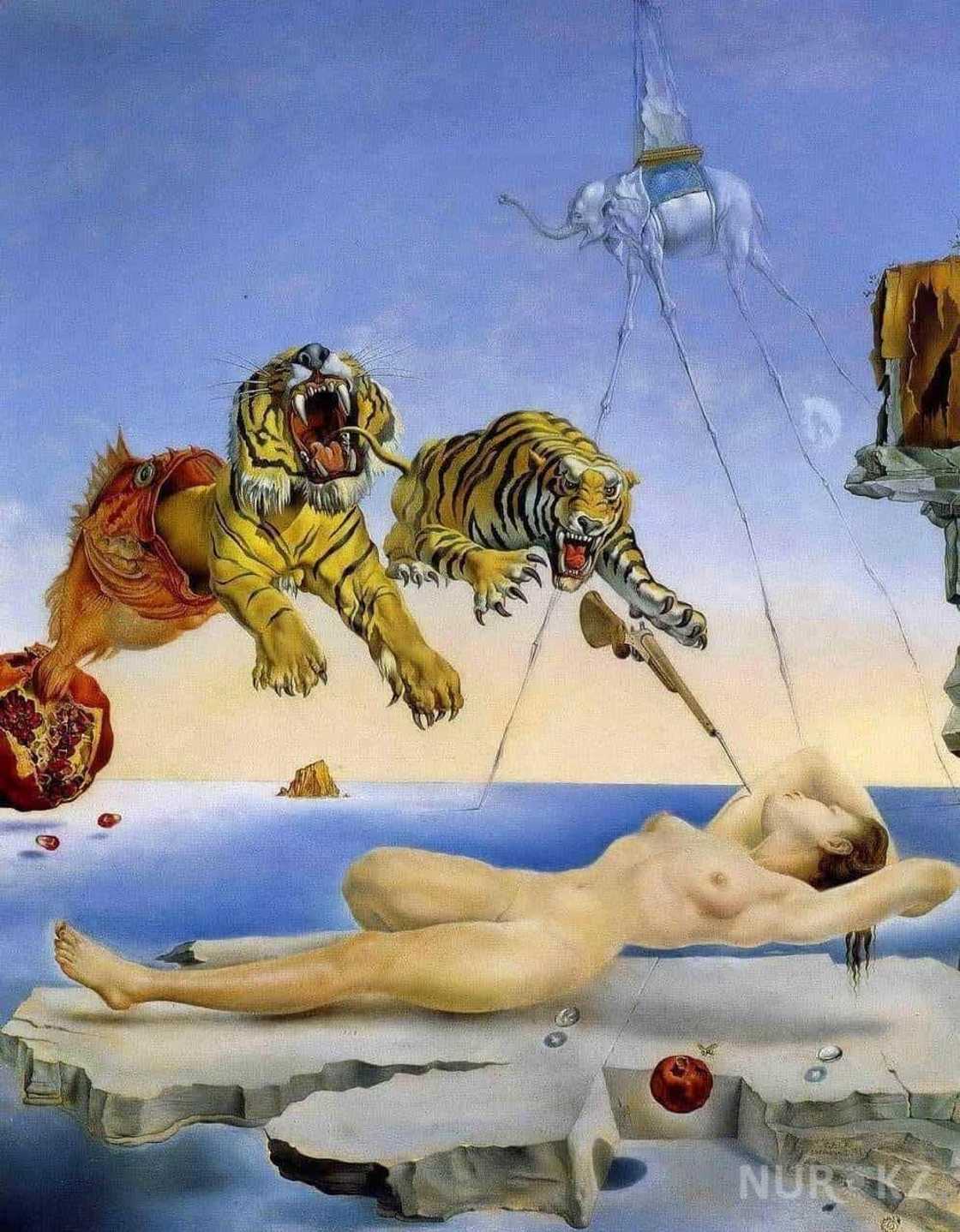
Source: Original
How can the birth of dreams be depicted in pictorial images? Freudian theory of sleep as manifestations of unconscious desires gave birth to this picture. In it, the author depicted a spate of subconscious images, which were based on the reality of a woman's sleep. And now, all in detail and in order.
The images in the picture clearly form two projections: a near-asleep woman is a reality; tigers, an elephant, a broken grenade, and the sea are unconscious, which generates dreams.
Salvador, in the image of her sleeping, captured Gala, her lover, muse and wife. The relaxed pose of the woman indicates that she is sleeping well. Beside it lies a pomegranate, above which a bee flies.
Bee buzzing, which is knocked back subconsciously, stimulates images that are associated with aggression, such as angry circus tigers leaping out of the mouths of fiery predator fish. That, in turn, emerges from a mystical core of a pomegranate, which resembles torn flesh (two seeds and drops of blood).
Given that the painting is completed with an image of an elephant on long legs with an iceberg on its back, the Freudian subtext of the painting is apparent: the woman's emotional perception of the cohabitation. It is associated with assault, sacrifice, and death (the shotgun pointed).
This painting by Salvador Dali is in Madrid's Thyssen-Bornemisza Museum.
My Wife Nude Contemplating Her Own Flesh (1945)
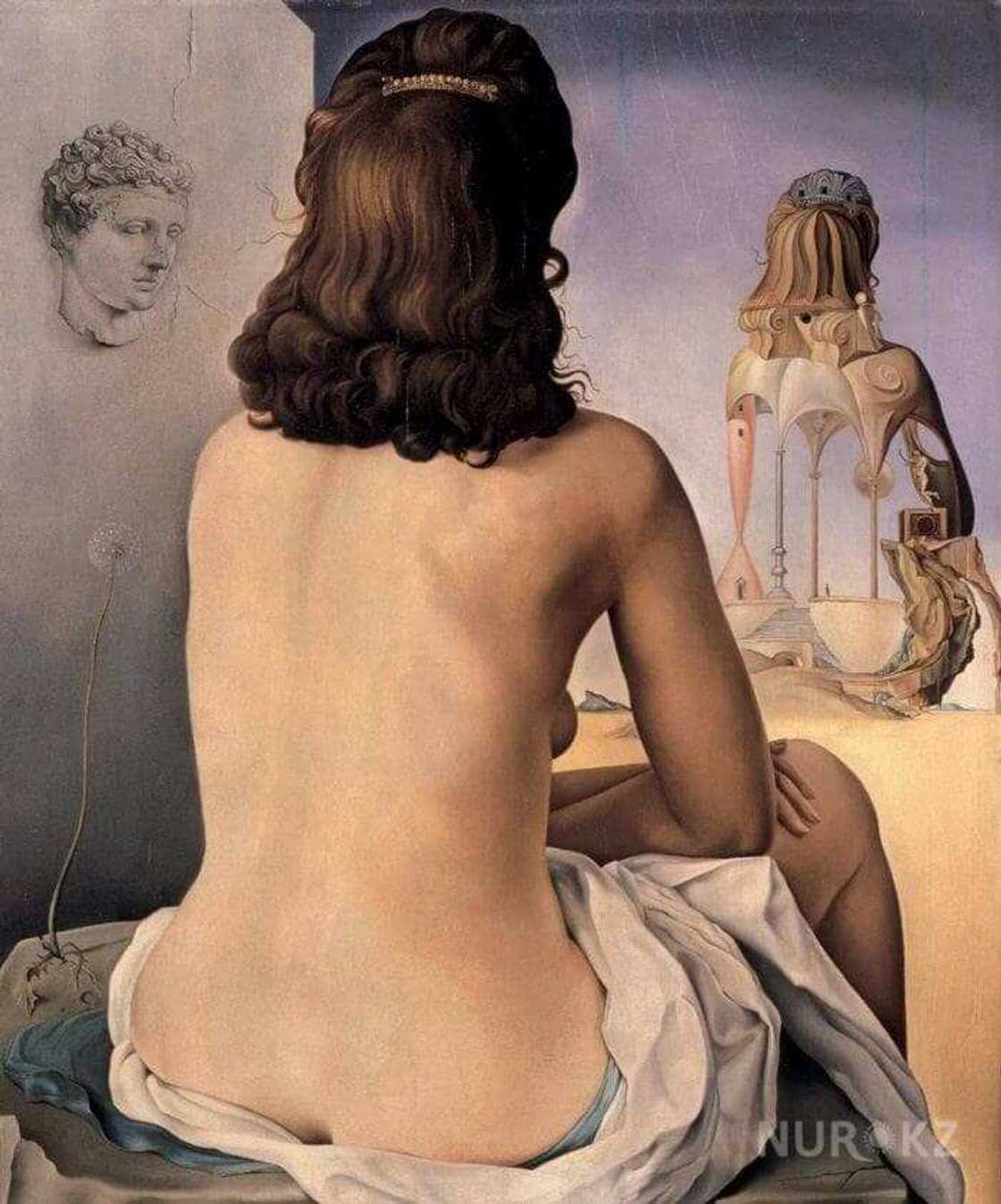
Source: Original
Gala was not just a wife and a beloved woman, but also a model of peace with which Salvador Dali sought to experience the eternal, beautiful, and inviolable.
The picture is imbued with the tragedy of perceiving the fleeting of existence and searching for what is eternal and incorruptible. As in most of Salvador Dali's paintings, the image is subordinated to a two-plane composition. In the foreground is a woman, represented from behind. The curves of her body are beautiful and tender. It is the embodiment of man, his bodily self.
To her right, there is a Greek bas-relief, a symbol of the eternity of culture, and a dandelion, a symbol of fleeting existence. The wall against which they are depicted is riddled with cracks, suggesting that these images reflect the perils of existence. It's the same for a woman: her hair is a continuation of those cracks.
But perspective is an eternity in itself. Once, as a child, Salvador Dali found an empty shell on the coast and was fascinated by its structure and perfect beauty. Through the empty bony shell was a glimpse of an eternal and unreachable sky. The artist carried this idea onto the image of the Gala. The heroine is projected into the background, where she becomes disembodied, turning into a peephole through which the world opens. Her head is a platform from which to see the heavenly sky.
The painting is housed in the Salvador Dali Museum-Theatre in Spain.
The Splintered Atom (1947)
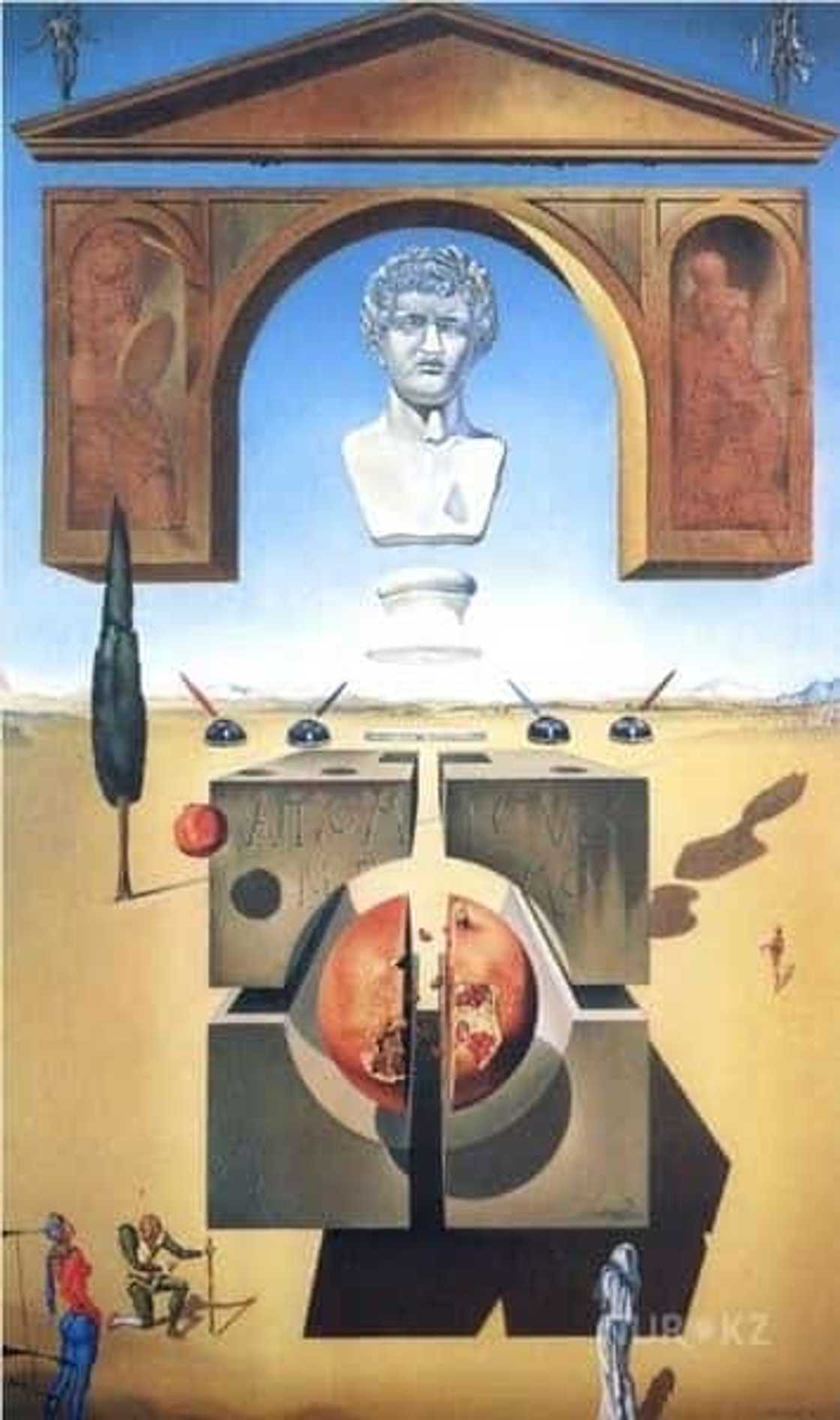
Source: Original
Salvador Dali was interested in science because he wanted to understand the riddle of life. This picture is dedicated to the most beautiful and horrible invention of the human mind: nuclear fission. The creative impulse for painting the canvas was the Hiroshima bombing.
The artist is fascinated, surprised, and at the same time depressed by this achievement of science. A central image of the pomegranates, encased in a processed granite clump of Greek writing. It is a symbol of scientific progress from antiquity to our time. The author is like saying to people, "You wanted this." Humanity wanted to know the mystery of creation and put itself in the service of the force of nature. It achieved this and was horrified.
Three figures - a medieval knight, a page, and a woman praying - froze in mute astonishment. They express interest, admiration, and fear of open power. The very image of the atom is threatening. The pomegranate is a symbol of life, of flesh that is shared by human thought, by human knowledge. It is no coincidence that the bust of Nero, one of Rome's most brutal rulers, which ended the history of the great Roman Empire, towers above this display.
The painting is now in a museum-theater in Figueres.
Salvador Dali dedicated a huge number of paintings to his muse, Gala (Elena Deaconova). Nor did the artist forget about himself. In an effort to get to know himself, the painter created a series of surreal self-portraits. "Cubist Self-Portrait," "Self-Portrait with Raphaelesque Neck," "Nude Dali," "Dali Sun," "Self-Portrait with L Humanite," "Dream," "Soft Self-Portrait" provide space for the psychoanalytic study of Dali's personality.
Most paintings of the genius of Surrealism are an investigation into everything one seeks to hide under the cloak of culture. Dali turns this inside out and opens his eyes to his own fears, complexes, and oppressed states. This attitude of the author shapes the relevance of and interest in his works.
Read also: At the Bottom: A summary and analysis of the play
Source: KAMI.com.gh









